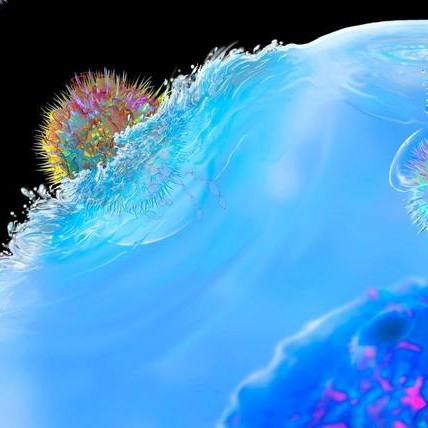-
Biotherapeutics
Regenerating the Lymph System

It was during a morning commute when Wendy Himley noticed her left foot was swollen. She wondered if she had sprained her ankle or stepped on a bee while wearing sandals. Nothing came to mind as a possible cause.
The swelling went away but later returned and moved from her foot to her ankle. She decided the swelling was not something to ignore.
The cause of the swelling remained elusive after a year of appointments, tests, and diuretics. She went searching for answers and ended up at Mayo Clinic and finally, with a diagnosis: primary lymphedema.
For Wendy, the reason why lymphedema developed remains a mystery. Primary lymphedema can occur for a variety of reasons at almost any stage in life. Secondary lymphedema can occur after lymph nodes are surgically removed or damaged by radiation during cancer treatment.
The lymph nodes contain a high level of immune cells that help destroy bacteria and protect the body. The glands in the neck can become tender and swollen when the body is fighting an infection.
The lymphatic system returns excess fluid to the circulatory system as it filters out waste products. When the network is disrupted, fluid in the body gathers in the impacted area and remains there without flow or movement. Over time, the buildup grows and increases in weight and becomes noticeable as swelling.
Secondary System
The good news is that for most patients, the condition can be controlled with a combination of physical and occupational therapy, exercise, and using compression wraps and garments. If treated early and diligently, lymphedema can be managed effectively over time.
 But for some patients, improvements are short-lived and the frustration and the swelling return.
But for some patients, improvements are short-lived and the frustration and the swelling return.
“I was diligent. I was very determined to get the swelling down,” Wendy says. “And all the wrapping I was doing wasn't getting the swelling down.”
Wendy was referred to Oscar J. Manrique, M.D., a reconstructive and plastic surgeon trained in a new lymphatic surgical procedure that helps patients with difficult to manage lymphedema.
“Physical therapy is the gold standard for treatment and a lot of patients benefit from it,” says Dr. Manrique. “However, some patients reach a plateau and don’t get better, so that’s when we look at restorative surgical procedures.”
Restorative, regenerative microsurgery
A team of surgeons recently performed the first lymph node transfer at Mayo Clinic. Using a minimally invasive procedure, David Farley, M.D. and Juliane Bingener-Casey, M.D. harvested the lymph nodes
from the patient’s abdomen and Dr. Manrique transferred the lymph nodes to the impacted area in Wendy’s left leg.
Dr. Manrique says the procedure is basically like bypass surgery where the lymph nodes are transferred and connected to an artery and a vein. The surgery reconnects the system.
“As the reconnected lymph nodes start working, they send signals to the body to start recreating channels that have not been working,” Dr. Manrique says. “The procedure sets in motion the regeneration of the lymphatic system and ultimately the circulation of the lymphatic fluid. In addition, it is believed that the transferred lymph nodes work like a sponge; they absorb the lymph fluid from the limb and bypass it to the venous system.”
As the lymphatic system is regenerated and returns to normal activity, patients start seeing the fluid volumes in the limb decrease and the lymphedema becomes easier for them to manage.
It can take up to a year for complete healing after lymph node transfer surgery. Wendy will continue to wear compression garments as needed and continue with therapy, but she says the maintenance is easier than before the surgery.
The long road back to normal
Jenny Bradt has been working with lymphedema patients like Wendy for many years. As a licensed physical therapist and certified lymphedema therapist, she sees a range from what she calls ‘stubborn lymphedema’ to cases that are easier to manage. She works with patients to design a treatment program with self-management as the goal.
Lymphedema therapists use a two-phase approach to help patients manage their condition. First is the reduction phase where manual therapy techniques are used and the patient is taught how to compression wrap. The patient is shown how to exercise while wearing the wraps. The physical activity in the compression wraps improves the muscle’s ability to move lymphatic fluid.
When the swelling is reduced and the limb is relatively stable, the therapist fits the patient with a compression garment for the second phase.
“We try to develop the most functional and easiest program they can manage and that fits within their lifestyle,” Bradt says. “We have to have good communication with the patient so that we know what’s happening, can problem solve together, and come up with an optimal program.”

Feeling much better
Wendy says she is feeling much better a few months after being the first patient at Mayo Clinic to undergo the procedure.
“The swelling is way down, and I can bend my leg. The bending and softening of my knee is amazing,” she says. “I saw results with this surgery immediately. And that’s huge. I truly wasn’t expecting it because of what I’ve been through before.”
Dr. Manrique says there is a significant volume reduction in Wendy’s leg after the surgery.
“She is already seeing improvement,” he says. “When these patients come to see us they wish something could be done. It’s like a new alternative. It’s a huge change for them in their lifestyle.”








